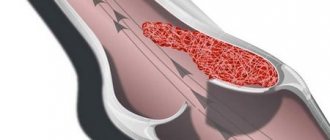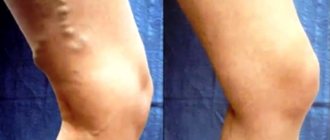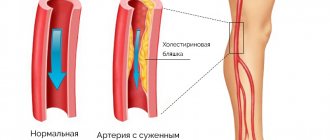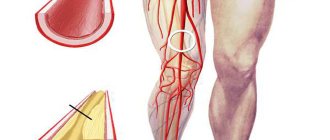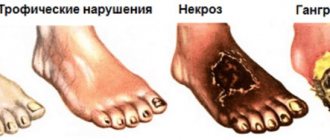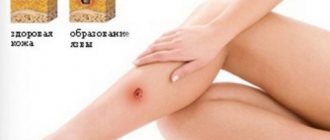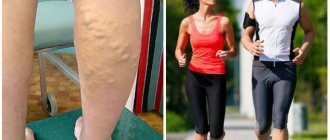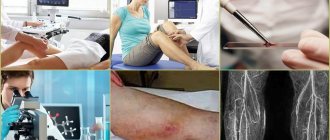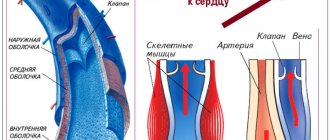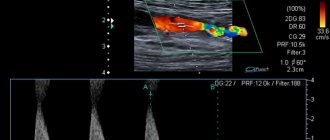What is chronic venous insufficiency?
Under this term, doctors combine a number of diseases that lead to long-term, sometimes lifelong, disruption of the venous outflow from the legs. The most common causes of chronic venous insufficiency are varicose veins and previous deep vein thrombosis (postthrombotic and/or postthrombophlebetic disease). Congenital disorders of the venous system are less common. I note that disturbances in venous flow are not always associated with disease. They can occur during pregnancy, obesity, long journeys, flights, prolonged standing and a sedentary lifestyle.
Forms of valve insufficiency
This disease is difficult to detect in the acute stage. The patient may suffer from just one symptom or face the full range of manifestations of the disease. The standard classification of CVI (chronic venous insufficiency) includes the following types of disease:
- deep vein insufficiency;
- insufficiency of the saphenous veins;
- insufficiency of perforating veins.
Subcutaneous and perforating vessels are most often affected. Deep veins are very rarely affected. Doctors in such cases speak of a secondary form of the disease.
Deep vein insufficiency
This pathology occurs in patients with a genetic predisposition to varicose veins. The vascular walls of the legs experience constant high pressure. Blood begins to leak through the veins to other adjacent tissues, which causes severe swelling and the appearance of compacted areas. Smaller vessels also suffer from this disease, because The swollen tissues begin to put pressure on them. Treatment of deep vein insufficiency is often conservative. Patients are advised to move more and use heparin-based ointments.
Insufficiency of saphenous veins
Most often, patients are diagnosed with this type of disease. The valves of the subcutaneous channels are destroyed, which is accompanied by vertical reflux. Numerous studies confirm that absolutely all valves can be damaged due to the disease. Blood can flow into the hip and greater subcutaneous line. The disease is easily detected using ultrasound examination.
Insufficiency of perforating veins
Perforating vessels connect the deep and saphenous veins. Valve failure of this segment of the circulatory system is accompanied by horizontal blood reflux. This pathology can only be eliminated through surgery. Most often, the disease develops in the lower leg.
Insufficiency of perforating veins is accompanied by the destruction of muscle, collagen and elastic tissues. As a result, the blood begins to stagnate and the blood vessels become denser. Due to the fact that the valves do not work well, the outflow of blood is disrupted. Fluid enters the subcutaneous vascular network, which leads to pain, bulging veins and a feeling of heaviness. The disease is accompanied by trophic ulcers and thrombophlebitis.
How does the venous system work?
The outflow of blood from the legs occurs through deep veins, located deep in the muscles, and subcutaneous veins, passing through the subcutaneous fatty tissue. The deep and superficial venous systems of the lower extremities are connected to each other by the so-called perforating veins. The fundamental feature of the structure of the leg veins is the valves, which orient the blood flow strictly towards the heart. In addition, valves in the connecting veins allow blood to flow from the saphenous veins to the deep veins and prevent its return. Venous valves are distributed unevenly: the largest number is located on the lower leg (up to 20-30) and the smallest (2-3) on the thigh.
Peculiarities
The valvular ridge in cross section contains connective tissue and bundles of smooth muscle cells. This can be observed during microscopic examination. The connecting elements create bundles that move onto the vessel wall. They are responsible for the connection between the roller and the base.
Normally, the rim of the great saphenous and femoral vein has a triangular shape. Its base is located along the wall, and the end is directed into the lumen of the vessel. The main feature is the well-defined connection between the valve ridge and the middle tunic of the vein. This appears as bundles of collagen fibers.
The structure of the roller consists of a valve and a wall. In the presence of varicose veins, you can observe different options and changes in structure. Normally, the cushion is pronounced and has a sufficient number of bundles of smooth muscle cells.
Why do venous valves malfunction?
The main reason is disruption of the normal functioning of the vein valves. The blood flow becomes chaotic, and in the veins, especially the subcutaneous ones, the pressure increases so much that the walls of the vessel cannot stand it and begin to expand. In addition, other symptoms of the disease appear. The force of gravity is of greatest importance.
They say that vein diseases are a kind of payment a person pays for the ability to walk upright. That is, people who spend a lot of time on their feet have the greatest risk of disease - for example, doctors, salespeople, hairdressers. Since the amount of pressure in the veins is directly proportional to height, it is believed that tall people are more prone to chronic venous insufficiency.
Another important reason leading to disruption of the venous valves is an increase in intra-abdominal pressure. This occurs during heavy lifting and pregnancy. Venous thrombosis, which almost completely destroys the valves in the affected vein, has a disastrous effect on the valves. In addition, venous valves can be destroyed as a result of frequent household or sports injuries.
The operation does not require anesthesia, does not lead to disability, is performed without incisions and under local anesthesia
Photo: clinic “No Varicose Veins”
What is perforating varicose veins
There are many diagnoses based on the results of Doppler scanning, and one of them is the incompetence of perforating veins. There are elements of the circulatory system whose function is sometimes forgotten. One of them is the perforating veins of the lower extremities. What it is ? The most striking example is the wreaths entwining the side surfaces of the foot.
The venous system has about 100 perforators that connect the deep lines with the subcutaneous ones. Their function is to create a buffer for the muscular-venous pump. The blood in them moves from the outside to the inside, where the femoral vein collects the outflow of the lower limb:
- Cockett's perforators work with the pump of the soleus muscle, and blood is sucked from them only when it relaxes.
- The Boyd's perforator below the knee joint connects the great saphenous vein, tibial and popliteal veins. It also suffers when sitting cross-legged, as well as in drivers who have to keep their foot on the pedal.
- Dodd's perforator is located at the entrance to Gunter's canal, and at the exit is the Gunter's perforator of the same name. The canal is located in the fascia formed by the vastus medialis and adductor magnus muscles.
When varicose veins are manifested by swelling of vessels that do not run vertically, but horizontally or diagonally, this is an incompetent perforating vein. What it is ? These veins pierce the membranes, carrying blood during each step.
A sedentary lifestyle leads to actual stagnation in the transitional reservoirs, which, against the background of compression, increases the risk of thrombosis. Compression of the fascia and, along with it, blood vessels is observed during prolonged sitting, wearing shoes with narrow tops, and tight trousers.
The term "incompetence" is a synonym for horizontal venous reflux. Normally, the outflow goes from the superficial to the deep highways, and reflux means fixation of the reverse movement. The cause is said to be incompetence of the valves of the communicating veins. The valve apparatus must prevent reverse flow.
It is believed that this mechanism leads to the spread of varicose veins and damage to deep vessels. Horizontal reflux is detected in the initial stages of the disease and at the same time doctors diagnose reverse blood flow in the saphenofemoral junction. This is the place where blood passes from the long saphenous vein to the deep femoral vein.
The reasons for its occurrence
Perforating varicose veins are not distinguished as a separate form of varicose veins. Most often, incompetence of communicating vessels is diagnosed as one of the causes of venous insufficiency. Perforating veins dilate in several cases:
- Increased venous outflow along superficial highways and excessive load on perforators.
- The absence of a muscle pump leads to valve incompetence and blood reflux.
- Incompetent deep veins increase retrograde flow without increasing pump volume—bringing blood upward.
Therefore, it cannot be said that the weakness of the perforator valves affects the function of the entire venous system.
The muscular-venous pump is one of the main factors in the return of venous blood to the heart. Even 30 years ago, Gardner and Fox described its components at four levels:
- foot along the lateral plantar veins (plantar muscles)
- tibia and soleus muscle;
- popliteal fossa and calf muscle;
- thigh - semitendinosus, biceps and quadriceps femoris;
The venous pump system begins with the venous arch of the foot and the marginal veins, where the muscle pump of the sole operates. During contraction of the gastrocnemius muscle, outflow is possible only through the superficial vessels, since the posterior tibial and peroneal veins are closed, and the blood from them flows upward. Under the influence of pressure, the blood partially flows into the superficial channel through the perforators - Cockett's zone.
As the muscle relaxes, the pressure drops. At the same time, in the deep channel the pressure decreases more significantly, so blood flows not only from below, but also from the perforators back. Including from the superficial veins, which collect blood from the venous arch. Therefore, the work of the muscular-venous pump “milks” blood from the venous system of the leg.
Relaxation of the calf muscle is possible only when placing the foot on the heel. If this does not occur, incompetence of the perforating veins of the leg develops. This is what is called the cause of varicose veins. In fact, it is a consequence of venous insufficiency.
Venous blood from the lower limb drains into the femoral vein, which drains into the iliac vein and the inferior vena cava, which passes through the diaphragm.
The increase in intra-abdominal pressure during inspiration is associated with the lowering of the diaphragm. As you exhale, the diaphragm rises, reducing pressure, and the muscular strength of the abdominal muscles helps pump blood from the inferior vena cava and iliac veins to the heart.
Weakness of the abdominal muscles and chronic diseases of the internal organs block the normal functioning of the diaphragm and venous outflow. The blood stagnates, which increases stagnation and pressure on the perforators.
The local cause of problems with perforating veins is muscle imbalances.
Only under conditions of relaxation of the fascial sheaths of the lower leg muscles does the deep veins fill and the perforators and superficial vessels empty. In conditions of a sedentary lifestyle, the calf muscles and biceps femoris are fascially shortened. The causes of overload of perforating veins are associated with blockage of venous outflow by habits and lifestyle:
- wearing high-heeled shoes;
- flat feet;
- violation of step biomechanics;
- prolonged sitting causes stagnation in the pelvis;
- habit of crossing legs.
Therefore, walking has always been considered a good prevention of varicose veins, and cycling, on the contrary, helps to compress blood vessels.
Why does the risk of developing chronic venous insufficiency increase during pregnancy?
There are several reasons for this. Mechanical factor: from the second half of pregnancy, the growing uterus increasingly compresses the inferior vena cava and iliac veins. Compression of the retroperitoneal veins reaches a maximum towards the end of pregnancy.
Blood circulation : as pregnancy progresses, circulating blood volume (CBV) increases by 15-25%. This well-known fact is associated with the need to ensure placental blood circulation. An increase in blood volume, in turn, causes additional stress on the heart and vascular bed.
Hormonal factors : Increased levels of sex hormones during pregnancy cause a number of changes affecting the venous system. Dilatation (expansion) of venules (small veins) develops, their inner and middle layers thicken. In the intima (inner part of the veins), immune complexes begin to accumulate, causing aseptic inflammation like phlebitis. The result is progressive phlebostasis. In addition to the direct effect on the venous wall, estrogens and progesterone cause a cascade of changes in the hemostatic system.
Dysproteinemia : during pregnancy, the level of blood albumin (protein) decreases, which disrupts the colloid-osmotic balance.
Hemostasis and hemorrheology : changes in the hemostatic system occur already in the first trimester of pregnancy. By the third trimester, the fibrinolytic activity of the blood (an indicator reflecting the ability of the blood to dissolve formed blood clots) decreases significantly and its viscosity increases. Depression of anticoagulation mechanisms reaches its maximum.
Nervous regulation of veins
The body's needs are constantly changing, so the veins actively adapt to changes by changing their diameter. It has been established that veins have constrictor (vasoconstrictor) fibers.
1 - Vein before the influence of the sympathetic impulse; 2 - After exposure to a sympathetic impulse, the vessel is narrowed.
Stimulation of the sympathetic chain leads to active contraction of the veins and improved wall tone. In addition, veins are more sensitive to sympathetic nerve irritation than arteries. The process of maximum sympathetic stimulation reduces the blood volume in the veins by about a third. The constrictor nerve fibers of the veins in the body are activated with the help of baroreceptors, as well as with the participation of the reflexogenic zone of the heart and the same zone of the lungs. These receptors, in accordance with their location, signal changes in the central blood volume.
If blood flow towards the heart decreases, receptor activity decreases, resistive and capacitive vessels narrow. As experimental and clinical observations have shown, venous return can be reflexively limited by stretching the cavities of the heart.
The effect of constrictors on the vein wall largely depends on the initial degree of its stretching. In cases where the pressure inside the vessels determines their cross-section in the shape of a circle, the lumen of the veins narrows and the blood moves towards the heart.
If the venous wall is in a relaxed state, and the cross-sectional area of the vessel takes the shape of an ellipse, sympathetic impulses do not have a significant effect on the capacity of the veins, and sometimes can help increase their capacity by changing the configuration of the vessel.
If the circulatory system were made in the form of connected rigid tubes, then sudden changes in posture would not have such a dramatic effect on venous return.
But since each human vein is a thin-walled vessel, significantly increasing its volume even with a slight increase in pressure, the appearance of orthostatic load leads to the “deposition” of blood and a reduction in blood supply to the heart.
When a person is in a horizontal position, the level of pressure in the veins of the arms and legs is approximately the same and amounts to 10-15 mm Hg. Art.
When a person stands up, the level of pressure in the veins of the legs increases greatly; in the lower legs it reaches 85-100 mm Hg. Art. depending on height. The deep and superficial veins of the lower extremities have the same level of pressure. Since the venous sinuses of the calf muscles are large, and the muscular layer of the deep veins is less developed in comparison with them, most of the blood mass is located in the deep veins. The capacity of the venous bed directly depends on the muscle mass of the limb.
The normal increase in the amount of blood in both lower extremities when standing up ranges from 300 to 400 ml. This redistribution of blood entails a reduction in the amount of venous blood going to the heart, as well as a decrease in cardiac output by up to 10%; this can lead to hypotension and even fainting.
How does venous insufficiency manifest?
The first signs of trouble with the venous system are swelling of the lower leg and foot at the end of the day, a feeling of heaviness and fullness in the calves. Patients pay attention to the fact that shoes that are comfortable in the morning begin to feel tight in the evening; socks or knee socks leave deep marks on the skin. Typically, these symptoms decrease with walking and after a night's rest.
Later, bursting pain in the calves, a feeling of heat in the legs and night cramps in the calf muscles appear. External changes are also taking place. Small blue-red spider veins, dark blue intradermal veins and intricately convoluted varicose veins form on the thighs and legs.
Varicose veins in the form of dark blue conglomerates, resembling bunches of grapes, quickly appear on the thighs and legs. As the disease progresses, the skin of the lower leg becomes dry and sensitive to various injuries. Then small dark brown islands appear, gradually merging into a single archipelago. In its center, a skin area resembling a stearin deposit is formed, and after this a trophic ulcer opens.
News on the topic of varicose veins on the legs treatment
Read more
Varicose veins of the legs will be treated using “biological” glue
A new treatment for varicose veins of the lower extremities has been approved in the United States. Now the diseased vein will not be excised with a scalpel or burned with a laser - it will be turned off from the circulatory system, “clogged” with a special biological glue.
Read more
Instead of a scalpel - foam: new in the treatment of varicose veins
Varicose veins of the lower extremities are a common disease. It is dangerous due to its complication – thrombophlebitis. Until now, the most reliable method of treating varicose veins has been surgery, but now it is increasingly being replaced by sclerotherapy.
Read more
Working on your feet: how to avoid disaster
Many of us spend most of the day on our feet, and by evening the feeling of heaviness in our legs becomes unbearable. What about people who have to spend every working day on their feet? Spider veins, heaviness and swelling of the legs are just the “start” of varicose veins. Of course, the easiest way is to advise changing jobs, but is it so easy to implement... Essentially, this means that the only sure way to solve the problem is to take timely care to prevent varicose veins.
Read more
Working on your feet: how to avoid disaster
Many of us spend most of the day on our feet, and by evening the feeling of heaviness in our legs becomes unbearable. What about people who have to spend every working day on their feet? Spider veins, heaviness and swelling of the legs are just the “start” of varicose veins. Of course, the easiest way is to advise changing jobs, but is it so easy to implement... Essentially, this means that the only sure way to solve the problem is to take timely care to prevent varicose veins.
Read more
Satisfactory condition of veins as the basis of health, beauty and longevity
Millions of people suffer from various vein diseases, among which the most common and unpleasant are varicose veins and hemorrhoids. Symptoms, complications and consequences of vein diseases seriously spoil the lives of people suffering from them and encourage scientists and doctors to look for more and more new ways to combat this scourge. The result of these searches are, among other things, modern powerful and effective medications that can alleviate the condition of a patient with venous pathology, speed up the healing process and prevent their occurrence and development.
Read more
An aerosol with skin cells will relieve trophic ulcers
With chronic varicose veins of the legs, the nutrition of tissues, primarily the skin, is disrupted. Because of this, the progression of the disease leads to the formation of trophic ulcers. Now it will be possible to successfully treat such ulcers using a special aerosol.
Read more
How to heal non-healing wounds?
In some diseases (diabetes mellitus, varicose veins, atherosclerosis of the lower extremity vessels), patients develop non-healing wounds and ulcers on their legs, which cause serious suffering to the patients. These are so-called trophic ulcers, the cause of the formation and long-term existence of which is a violation of the blood supply and nutrition of the tissues of the lower leg and foot. The use of antibiotics, hormonal drugs and surgical operations give short-term results. What can really help?
Or maybe there is no need to treat CVI at all?
In principle, the question is reasonable. After all, dozens and even hundreds of people walk around all their lives with “veins in their legs” and supposedly nothing happens to them. That's what they say. In fact, they experience very painful sensations and constantly expose themselves to the risk of complications. Ulcers are not the most unpleasant thing. In a number of studies conducted mainly in Europe on fair-skinned people, the incidence of venous thromboembolism, standardized by age and sex, ranged from 30 to 117 cases per 100 thousand people. What is this and how to understand it?
Venous thromboembolism is when a blood clot first forms in the veins, then breaks off and travels to the heart. After this the heart stops. Now just count how many people live in Krasnoyarsk, divide the number by 100 thousand and you will understand for yourself whether there is a risk. Better yet, “try on” an ulcer for yourself. Do you need it? Moreover, modern technologies make it possible to get rid of these troubles quickly, practically painlessly and effectively. One of the most effective is the EVLC (endovasal laser coagulation) method.
Degrees of valve insufficiency
You need to start treating the disease from its first symptoms, but patients rarely turn to the doctor so quickly. More often, the patient comes when the valves are severely damaged and do not perform their functions well. Formally, there are 4 degrees of severity of the disease. Their detailed description is presented in the table below.
| Degrees | Features of manifestation |
| Zero | Patients have virtually no signs characteristic of valvular insufficiency. |
| Spider veins begin to appear on the skin. | |
| After prolonged or heavy physical activity, veins appear in the legs. | |
| At the end of the day there is a feeling of heaviness in the limbs. | |
| First | The heaviness in the legs increases. |
| A mild pain syndrome appears. | |
| The patient begins to get tired faster. | |
| Second | Swelling of the legs occurs not only at the end of the day or after physical activity, but also in the morning. |
| Pigment spots appear on the surface of the skin. | |
| The pain in the limbs becomes severe. | |
| There are problems with movement. | |
| Third | Trophic ulcers are added to the symptoms listed above. |
| Blood clots form in the veins, which leads to an increased risk of thromboembolism. |
What is special about EVLC?
Before the advent of EVLT, it was not possible to get rid of swollen veins in the legs so quickly, easily and effectively by any of the previously known methods. The main advantage of EVLT is an excellent cosmetic result with minimal trauma. Unlike open surgery, the procedure takes from 20 to 40 minutes, does not require anesthesia, is performed without incisions, under local anesthesia, and it is possible to treat both legs at the same time. In this case, the patient experiences minimal pain and does without bruises or hematomas. There is no need for hospitalization, there is no loss of ability to work. There are minimal postoperative complications.
Getting rid of veins that have lost their function is also possible with the help of miniphlebectomy, a gentle removal procedure through a small incision or puncture.
The laser beam “seals” the vein from the inside; in a maximum of six months it will disappear
Photo: Maria Lenz
To treat varicose veins in the initial stages of the disease and on vessels of not very large diameter, the clinic uses the sclerotherapy method, which is very effective and inexpensive. The procedure is not surgical in nature; it consists of introducing special medications directly into the affected vessel using a syringe with a very thin needle. Spider veins, spider veins, and small veins that are visible through the skin are removed.
Vascular thrombosis in the legs
Thrombosis of subcutaneous vessels is a frequent companion to varicose veins. Superficial diseases of the veins of the lower extremities associated with varicose veins. Vein disease easily reveals itself with characteristic signs on the legs:
- Red-violet vascular veins.
- Inflammatory infiltrate along the vein.
- Pain in the affected area.
Vein thrombosis in the legs requires long-term treatment from several months to a year. First of all, when diagnosing thrombosis, the patient is removed from the acute stage of the pathology. To do this, a person undergoes a course of heparin therapy and the use of thrombolytic anti-inflammatory drugs in a hospital.
For thrombosis and varicose veins on the legs, it is recommended to wear compression products when moving. Compression stockings can be removed during rest. Such products provide good support for enlarged veins, preventing their further swelling. Due to the special porous structure of the fabric, blood circulation improves.
Latest information: Causes of leg swelling in men
If a relapse occurs, who is to blame and what to do?
If all therapeutic and preventive measures are followed, relapse is rare. The fact is that the weakness of the venous wall is a property of the body, the same as eye color, nose shape, hair color, fingerprints. This is how you are made. During the course of treatment it is impossible to remove all the veins, and it is not necessary. The disease can occur again in those veins that remain. In addition, such patients often have anatomical features of the structure of the venous system.
But we must always remember that the disease cannot defeat us only as long as we resist it. As soon as we stop resisting, the disease comes with renewed vigor. Therefore, preventive measures and doctor’s recommendations must be followed, even when everything seems to be fine.
What treatment is prescribed?
Perforating insufficiency of the veins of the lower extremities should not be attempted to be eliminated on your own. Self-medication can negatively affect blood clotting and provoke thrombosis or bleeding. To eliminate the pathology, the doctor selects a course of therapy individually. Drugs of several pharmacological groups are used:
- NSAIDs;
- histamine receptor blockers;
- antioxidants;
- multivitamins;
- venotonics;
- broad-spectrum phlebotonics.
Return to contents
The operation is performed in severe cases. If possible, elimination of venous insufficiency is carried out using minimally invasive methods, for example, sclerotherapy or laser coagulation. As a result, the affected vessels stick together and become scarred. If these methods are not able to solve the problem, surgical intervention is prescribed. The operation involves ligation or excision of the affected veins of the lower extremities. The following procedure methods are used:
- Crossectomy. The trunk of the saphenous vein is removed at the place where it connects to the deep vessel.
- Stripping. Part of the affected perforator is excised.
- Miniphlebectomy. Perforating veins of the leg are removed through punctures in the skin. The technique shortens the rehabilitation period and is easier to tolerate by patients.
Return to contents
Is it possible for people with CVI to play sports?
There is an opinion among patients that venous insufficiency and sports are incompatible. This is wrong. On the contrary, to improve the health of the venous system, active sports such as running, cycling, race walking and especially swimming are useful and necessary. Only those types of exercises that lead to leg injury should be excluded. However, playing sports too hard and for a long time can also be harmful. Moderation is important in everything. If you run, it’s not long, walking isn’t far. Various types of physical education, gymnastics, and aerobics are ideal.
Vein treatment
The main method of treating incompetent perforating veins is their ligation at the site of the inoperative valve. After undergoing an ultrasound examination of the legs, the doctor clearly identifies the places where the venous valves do not work.
Next, using a scalpel, a small incision is made, the desired vein is located, and in it there is a perforating vein. After this, a special medical clip is applied to the perforated area. The operation is performed under general anesthesia, after which the patient spends some time in the hospital under the supervision of doctors.
If you did not have time to conduct an ultrasound examination before the operation, the doctor will look for an area with an imperfect perforating vein at random or refuse the patient to undergo surgical intervention.
The patient needs to gain strength and patience, as this period will be accompanied by severe pain, swelling of the legs, and the formation of bruises. Sometimes a scar may form at the incision site.
After the operation, doctors recommend that the patient wear special compression garments.
The rehabilitation period depends on the experience of the surgeon; in some cases, patients may feel numbness in the heel area, which will disappear after some time.
Is it possible to drive a car or fly on an airplane?
Staying immobile for a long time (driving, in a bus or airplane seat) disrupts the flow of blood through the veins, which can lead to an increase in venous insufficiency. Therefore, during long trips it is necessary to “insure yourself.” First of all, bandage your shins with an elastic bandage or put on special medical socks, stockings or tights. 10-15 days before the trip, start taking medications that improve venous outflow, for example, Detralex, Antistax, Ginkor, Anavenol.
Clinic “No Varicose Veins”:
Address : Krasnoyarsk, st. May 9, 51 Phone Website : varicose-net.rf
When traveling by car, you should stop every 1.5-2 hours and walk briskly for 10-15 minutes. During long flights or bus rides, it is advisable to stand up and walk around the cabin for a few minutes. In addition, periodic vigorous flexion and extension of the legs at the ankle joint are useful. So there are no special contraindications to traveling by car or plane.
Prognosis and prevention
To prevent the development of perforating insufficiency, it is recommended to adhere to the following rules:
- do leg exercises;
- wear compression socks or stockings;
- avoid hypothermia and overheating of the lower extremities;
- walk 2 km daily;
- do not wear tight clothes and high-heeled shoes;
- Avoid staying in one position for a long time.
Insufficiency of perforating vessels is considered a precursor to the development of varicose veins. Ignoring the symptoms of the disease and lack of necessary therapy leads to the development of complications and worsens the prognosis. Poor circulation and blood clots can cause death. The sooner the patient seeks medical help, the better the prognosis.
Most of us are familiar with such an unpleasant disease as varicose veins of the lower extremities. However, not everyone knows that the initial stage of the disease is venous vascular insufficiency or, as it is also called, incompetence of perforating veins.
Let's take a closer look at what kind of disease this is, what the causes of its occurrence are and what the consequences may be if treated incorrectly and untimely.
What is valve incompetence and how is it treated?
Venous valves in the vessels of the human lower extremities are susceptible to various pathologies. This disease develops both in utero and in early childhood, when the venous system is properly formed.
With congenital pathology, there is a risk of developing varicose veins in childhood or early youth. This disease most often occurs if the valves are completely absent at birth.
Factors that influence the formation of varicose veins can destroy even previously healthy valves. As the disease progresses, relative insufficiency develops and the valves become weakened.
Most often, such changes affect superficial vessels . Incompetence of the ostial valve of the great saphenous vein occurs much less frequently and is associated with general dilation of the veins.
The inferiority of individual valves can be combined with deformation of others that are located below. With age, the condition worsens, and atrophic processes of the valves occur.
When thrombosis occurs, the valves are also subject to deformation. In addition, such changes can be provoked by mechanical trauma. If a person suffers severe damage to the lower extremities, the valve flaps may become deformed or completely rupture.
There are several stages of pathology development:
- With zero degree of disease, valve insufficiency practically does not manifest itself in any way. Only during heavy physical exertion can veins protrude and vascular mesh appear.
- The first degree is characterized by heaviness and pain in the legs. The lower extremities swell in the evening, and cramps may appear.
- In the second degree of the disease, swelling and pain are observed not only after physical overexertion, but also in a state of complete rest. A person constantly feels discomfort, sometimes he cannot even fully move. Pronounced pigment spots may appear on the skin.
- The third degree of the disease is accompanied by the formation of trophic lesions. There is a possibility of blockage of the ostial valve of the great saphenous vein, which can lead to death of the patient. Therefore, urgent surgical intervention is necessary.
Treatment for incompetent valves in the veins of the lower extremities includes:
- use of laser for sclerotherapy;
- the use of physiotherapy (electrophoresis);
- compression tights or stockings;
- exercise therapy techniques to strengthen blood vessels;
- painkillers and antiseptic drugs (to an advanced extent);
- endoscopic valve repair surgery.
It is recommended to start treatment with the primary manifestations of valve insufficiency, otherwise time may be wasted and all physiotherapeutic treatment methods will be ineffective.
How do venous valves work and what do they do?
The venous valve is a fairly important element of the circulatory system.
It is with its help that the movement occurs towards the heart, overcoming the force of gravity. They are extremely important, but vulnerable, which is why statistically many people suffer from valvular insufficiency. p, blockquote 1,0,0,0,0 –>
Blood from the artery is sent to the aorta from the left ventricle. It is from there that it flows to other arteries, nourishing organs and tissues. Then they are divided into small structures and forms.
p, blockquote 2,0,0,0,0 –>
Blood, circulating through the capillary network, supplies oxygen and collects metabolic products. Subsequently, this blood must be collected in large veins that enter the right atrium.
p, blockquote 3,0,0,0,0 –>
Veins have a unique structure, which is determined by their functionality. They have built-in special valves that prevent the backflow of blood.
p, blockquote 4,0,0,0,0 –>
The presence of valves in the circulatory system was first written about in the dissertation on anatomy of an Italian doctor in the 16th century. But their presence in the body was officially recognized only at the end of the 17th century. This was proven experimentally by Dr. William Harvey. The valves are able to regulate the blood circulation process, directing them in the right direction. Similar adaptations are found in some animal species. Not every vessel has valves. For example, they are not present in vessels such as the inferior vena cava and superior vena cava.
p, blockquote 5,0,1,0,0 –>
What's in this article:
Treatment options
There are different treatments for deep vein valve insufficiency in the legs. Unfortunately, surgery cannot cure the disease. Removing veins is effective if they are damaged by varicose veins, but valve problems will remain with you. The main goal of treatment is to normalize the functioning of vascular valves. This can be achieved in the following ways:
- taking medications that normalize tissue trophism and blood composition;
- performing specialized exercises for the legs;
- normalizing nutrition;
- resorting to physiotherapeutic techniques;
- by surgically removing severely damaged veins.
Methods of treating the disease directly depend on the health status of the individual patient. Compression therapy is not suitable for everyone, nor is taking anticoagulants. If your doctor allows it, you can use herbal infusions to normalize your condition.
Medicines
The basis of drug treatment is drugs that improve blood flow in tissues and help restore vascular elasticity. Doctors often prescribe anti-inflammatory drugs to patients, which not only help relieve pain, but also reduce general swelling of the limbs. When blood thickens, patients should take Aspirin and other antiplatelet agents. Most often, patients are prescribed the following medications:
The type of medications prescribed depends on the patient's condition. For trophic ulcers, external preparations with antiseptics are prescribed, which will accelerate wound healing. For patients with dermatitis and eczema, doctors recommend using local glucocorticosteroids. Absolutely all patients are prescribed phlebotonics.
Magnetotherapy
As the name suggests, this physiotherapeutic treatment is based on the use of magnetic fields. It is believed that this effect reduces blood viscosity, eliminates joint pain, etc. The patient is placed in a special apparatus (magnetic turbotron), which generates magnetic fields. During the procedure, the characteristics of the magnetic field are determined individually for each patient. The course of treatment is 10-15 sessions. Doctors recommend undergoing procedures at the same time.
Compression therapy
This treatment method is based on increasing the ambient pressure around the veins. Compression therapy helps to enhance venous outflow, normalize the functioning of vascular valves, reduce blood viscosity, reduce the amount of interstitial fluid and relieve edema. This treatment helps get rid of leg cramps and promotes the healing of trophic ulcers. Compression therapy includes:
- wearing special jersey;
- use of elastic bandaging;
- hardware procedures for creating variable compression.
It is convenient for patients to use compression hosiery in everyday life. Putting them on is as easy as regular tights or stockings. All products are developed taking into account the anatomical structure of the legs, so they do not cause discomfort when worn. Compression products can be preventive and therapeutic. Their type is determined by the doctor. To prevent complications from valve insufficiency and in the absence of funds to purchase compression hosiery, you can practice elastic bandaging. The rules for applying a bandage are as follows:
- The roll is always unrolled outward.
- They begin to wrap the leg from the toes.
- The heel should be tightly wrapped with a bandage.
- Special pads are placed on the flat areas of the legs and pads on the ankles to prevent the formation of bedsores.
- Toward the hip, the pressure decreases rather than increases.
- If bandaging is done correctly, the fingertips will turn blue when lying down, but when walking they will return to their natural color.
Compression with the help of special devices is indicated for progressive valvular insufficiency. Pneumatic compression is most often used. Devices of this type can also be purchased for home use. Mercury compression is used if the patient has a severe form of deficiency, accompanied by trophic disorders in the tissues.
Folk remedies
Herbal treatment is considered complementary. By itself, it cannot help cope with valvular insufficiency, but it can eliminate some of the unpleasant symptoms of this disease. Healers advise people suffering from this disease to take a decoction of rowan bark. To prepare it, you will need 200 grams of dry product and 1 liter of boiling water. The bark is placed in a thermos, filled with liquid, and left to infuse for 10 hours. The resulting decoction is taken 30 ml/day 3 times a day. The following remedies are considered effective:
- Infusion of hazelnut bark and leaves. 1 teaspoon of each type of raw material is mixed, and then 250 ml of boiling water is poured. Take the resulting decoction 75 ml 3 times a day.
- Pine foot bath. 1 kilogram of crushed pine needles is poured with 5 liters of boiling water. The solution should sit for 1-2 hours. Use the bath mixture. The temperature of the liquid should not be too high.
Types of disease
When it comes to problems with valves, doctors talk about acute and chronic venous insufficiency. The disease can also be functional and lymphovenous. Acute venous insufficiency is considered the most life-threatening. It is characterized by complete blockage of the vessel. The development of the chronic form of the disease can be completely stopped with timely treatment.
Chronic
Chronic circulatory failure is characterized by damage to the saphenous veins. If left untreated, it continues to progress, which can lead to damage to the deep veins and disability of the patient. The disease is accompanied by swelling in the lower leg. Not only the muscles of the lower leg suffer, but also the ankles. At the second stage of the disease, the patient begins to lose hair on his legs, and there is a violation of tissue pigmentation. At the third stage of chronic insufficiency, the patient is faced with ulcers and trophic disorders.
Acute
When a vein becomes blocked, blood flow is severely disrupted. Doctors call this condition acute vascular insufficiency. This condition is dangerous for 2 reasons. Firstly, it always develops in the deep veins, which in itself is very bad, because They provide the body with 90% of the blood. Secondly, this disease most often develops under the influence of leg injuries. Based on this, we can say that the vessel is damaged or pinched.
The disease is accompanied by severe pain in the limbs. When you try to stand up or move your leg, the pain will intensify. If you suspect acute venous insufficiency, you should immediately call an ambulance. Cold compresses can relieve the patient's condition. They use dense natural fabric. It is dipped in cold water and then applied to the affected area. This manipulation must be repeated for at least 60 minutes. You cannot take any medications before the ambulance arrives.
Lymphovenous
This type of illness affects about 40% of all middle-aged people. The disease manifests itself in mild and severe forms. As the name implies, in patients with this disease, not only the flow of blood, but also lymph is hampered. This disease is treated with medications, but surgical intervention for this type of disease rarely has a positive effect.
Functional
A distinctive feature of this form of insufficiency is that it occurs in people with completely healthy veins. Most often, the cause of its appearance is a person’s height, excess weight and taking hormonal medications. Surgeons, teachers, hairdressers and other specialists who have to be on their feet for long periods of time face functional impairment. Treatment is mostly conservative. Patients take medications and wear compression stockings to prevent the disease from affecting the veins.
What is valve incompetence and how is it treated?
Venous valves in the vessels of the human lower extremities are susceptible to various pathologies. This disease develops both in utero and in early childhood, when the venous system is properly formed.
With congenital pathology, there is a risk of developing varicose veins in childhood or early youth. This disease most often occurs if the valves are completely absent at birth.
Factors that influence the formation of varicose veins can destroy even previously healthy valves. As the disease progresses, relative insufficiency develops and the valves become weakened.
Most often, such changes affect superficial vessels . Incompetence of the ostial valve of the great saphenous vein occurs much less frequently and is associated with general dilation of the veins.
The inferiority of individual valves can be combined with deformation of others that are located below. With age, the condition worsens, and atrophic processes of the valves occur.
When thrombosis occurs, the valves are also subject to deformation. In addition, such changes can be provoked by mechanical trauma. If a person suffers severe damage to the lower extremities, the valve flaps may become deformed or completely rupture.
There are several stages of pathology development:
- With zero degree of disease, valve insufficiency practically does not manifest itself in any way. Only during heavy physical exertion can veins protrude and vascular mesh appear.
- The first degree is characterized by heaviness and pain in the legs. The lower extremities swell in the evening, and cramps may appear.
- In the second degree of the disease, swelling and pain are observed not only after physical overexertion, but also in a state of complete rest. A person constantly feels discomfort, sometimes he cannot even fully move. Pronounced pigment spots may appear on the skin.
- The third degree of the disease is accompanied by the formation of trophic lesions. There is a possibility of blockage of the ostial valve of the great saphenous vein, which can lead to death of the patient. Therefore, urgent surgical intervention is necessary.
Treatment for incompetent valves in the veins of the lower extremities includes:
- use of laser for sclerotherapy;
- the use of physiotherapy (electrophoresis);
- compression tights or stockings;
- exercise therapy techniques to strengthen blood vessels;
- painkillers and antiseptic drugs (to an advanced extent);
- endoscopic valve repair surgery.
It is recommended to start treatment with the primary manifestations of valve insufficiency, otherwise time may be wasted and all physiotherapeutic treatment methods will be ineffective.

